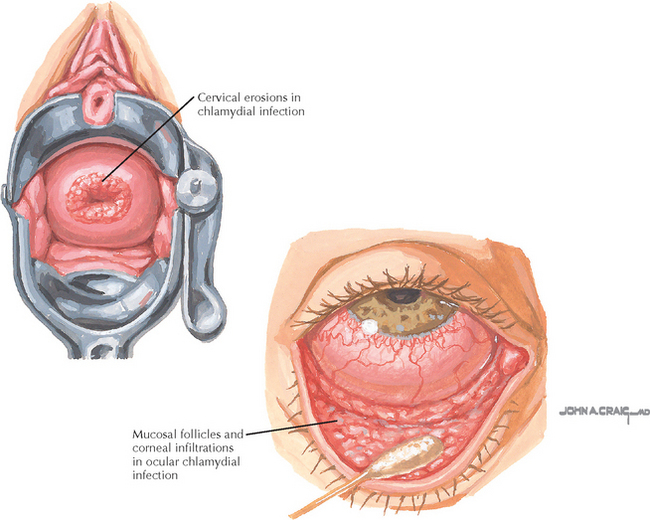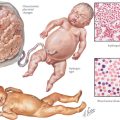Chapter 46 Sexually Transmitted Infections: Chlamydia Trachomatis
INTRODUCTION
ETIOLOGY AND PATHOGENESIS
DIAGNOSTIC APPROACH
Workup and Evaluation
MANAGEMENT AND THERAPY
Nonpharmacologic
Drug(s) of Choice
Alternative Drugs
FOLLOW-UP
MISCELLANEOUS
Adair CD, Gunter M, Stovall TG, et al. Chlamydia in pregnancy: a randomized trial of azithromycin and erythromycin. Obstet Gynecol. 1998;91:165.
Jacobson GF, Autry AM, Kirby RS, et al. A randomized controlled trial comparing amoxicillin and azithromycin for the treatment of Chlamydia trachomatis in pregnancy. Am J Obstet Gynecol. 2001;184:1352.
Silverman NS, Sullivan M, Hochman M, et al. A randomized, prospective trial comparing amoxicillin and erythromycin for the treatment of Chlamydia trachomatis in pregnancy. Am J Obstet Gynecol. 1994;170:829.
Cook RL, Hutchison SL, Ostergaard L, et al. Systematic review: noninvasive testing for Chlamydia trachomatis and Neisseria gonorrhoeae.. Ann Intern Med. 2005;142:914.
Lau C-Y, Qureshi AK. Azithromycin versus doxycycline for genital chlamydial infections: a meta-analysis of randomized clinical trials. Sex Transmit Dis. 2002;29:497.
Lyss SB, Kamb ML, Peterman TA, et al. Chlamydia trachomatis among patients infected with and treated for Neisseria gonorrhoeae in sexually transmitted disease clinics in the United States. Ann Intern Med. 2003;139:178.
Martin DH, Mroczkowski TF, Dalu ZA, et al. A controlled trial of a single dose of azithromycin for the treatment of chlamydial urethritis and cervicitis: the azithromycin for Chlamydial Infections Study Group. N Engl J Med. 1992;327:921.
Ness RB, Trautmann G, Richter HE, et al. Effectiveness of treatment strategies of some women with pelvic inflammatory disease: a randomized trial. Obstet Gynecol. 2005;106:573.
Ostergaard L, Andersen B, Olesen F, Moller JK. Efficacy of home sampling for screening of Chlamydia trachomatis: randomized study. BMJ. 1998;317:26.
Peterman TA, Tian LH, Metcalf CA, et alRESPECT-2 Study Group. High incidence of new sexually transmitted infections in the year following a sexually transmitted infection: a case for rescreening. Ann Intern Med 145 2006 564-572 Summary for patients in: Ann Intern Med. 2006;145:I44.
Tanaka M, Nakayama H, Sagiyama K, et al. Evaluation of a new amplified enzyme immunoassay (EIA) for the detection of Chlamydia trachomatis in male urine, female endocervical swab, and patient-obtained vaginal swab specimens. J Clin Pathol. 2000;53:350.
American College of Obstetricians and Gynecologists. Sexually transmitted diseases in adolescents. ACOG Committee Opinion 301. Washington, DC: ACOG, 2004.
Centers for Disease Control and Prevention. Recommendations for the prevention and management of Chlamydia trachomatis infections, 1993. MMWR. 1993;42:1.
Centers for Disease Control and Prevention. Sexually transmitted diseases treatment guidelines, 2006. MMWR. 2006;55:21. 38.
Crossman SH. The challenge of pelvic inflammatory disease. Am Fam Physician. 2006;73:859.
Eckert LO, Lentz GM. Infections of the lower genital tract. In: Katz VL, Lentz GM, Lobo RA, Gershenson DM, editors. Comprehensive Gynecology. 5th ed. Philadelphia: Mosby/Elsevier; 2007:600.
Faro S. Chlamydia trachomatis: female pelvic infection. Am J Obstet Gynecol. 1991;164:1767.
Jones RB. New treatments for Chlamydia trachomatis.. Am J Obstet Gynecol. 1991;164:1789.
Lee HH, Chernesky MA, Schachter J, et al. Diagnosis of Chlamydia trachomatis genitourinary infection in women by ligase chain reaction assay of urine. Lancet. 1995;345:213.
Low N. Screening programmes for chlamydial infection: when will we ever learn? BMJ. 2007;334:725.
Mangione-Smith R, McGlynn EA, Hiatt L. Screening for chlamydia in adolescents and young women. Arch Pediatr Adolesc Med. 2000;154:1108.
Miller KE. Diagnosis and treatment of Chlamydia trachomatis infection. Am Fam Physician. 2006;73:1411.
Morrison RP. New insights into a persistent problem—Chlamydial infections. J Clin Invest. 2003;111:1647.
Osser S, Persson K. Chlamydial antibodies in women who suffer miscarriage. Br J Obstet Gynaecol. 1996;103:137.
Peipert JF. Clinical practice. Genital chlamydial infections. N Engl J Med. 2003;349:2424.
Skolnik NS. Screening for Chlamydia trachomatis infection. Am Fam Physician. 1995;51:821.
Stamm WE. Chlamydia trachomatis infections: progress and problems. J Infect Dis. 1999;179:S380.








